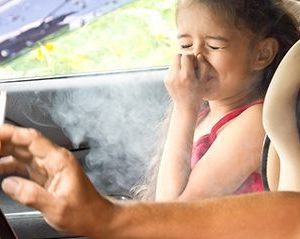- Navigating Your Midlife Crisis: Embracing New Possibilities
- City Raccoons Showing Signs of Domestication
- Mapping the Exposome: Science Broadens Focus to Environmental Disease Triggers
- One Week Less on Social Media Linked to Better Mental Health
- Your Brain Changes in Stages as You Age, Study Finds
- Some Suicide Victims Show No Typical Warning Signs, Study Finds
- ByHeart Formula Faces Lawsuits After Babies Sickened With Botulism
- Switch to Vegan Diet Could Cut Your Greenhouse Gas Emissions in Half
- Regular Bedtime Does Wonders for Blood Pressure
- Dining Alone Could Mean Worse Nutrition for Seniors
Secondhand Smoke Is Sending Kids to the ER

Nonsmokers usually try to avoid secondhand smoke, but many kids have no option, and now a new study finds tobacco smoke exposure puts them at higher risk of hospitalization.
Compared to other kids, those exposed to secondhand smoke were more likely to have had an urgent care visit over a one-year period, and to incur higher costs for such visits. They also were nearly twice as likely to be admitted to the hospital.
The findings were published online recently in the journal PLOS ONE.
“Despite major progress in tobacco control, about four in 10 children remain exposed to tobacco smoke,” said lead author Ashley Merianos, associate professor of health promotion and education at the University of Cincinnati.
“This exposure places developing children at higher risk for many health problems, including respiratory illnesses such as asthma, bronchiolitis and pneumonia,” she said in a university news release.
The findings highlight the need for health care providers to encourage people to make homes and cars smoke-free, said Merianos, who is also a research affiliate of Cincinnati Children’s Hospital Medical Center, the Thirdhand Smoke Consortium and the American Academy of Pediatrics Tobacco Consortium.
Senior study author Dr. Melinda Mahabee-Gittens, a pediatric emergency doctor and professor of pediatrics at Cincinnati Children’s, suggested the findings are a call to action to screen and advise parents who smoke or vape.
“If every health care provider were to use each pediatric visit as an opportunity to…counsel parents about the dangers of secondhand and thirdhand smoke exposure to their children, rates of pediatric tobacco smoke exposure would decline,” she said.
More information
The U.S. Centers for Disease Control and Prevention has more on secondhand smoke and children.
SOURCE: University of Cincinnati, news release, March 24, 2021
Source: HealthDay
Copyright © 2025 HealthDay. All rights reserved.










